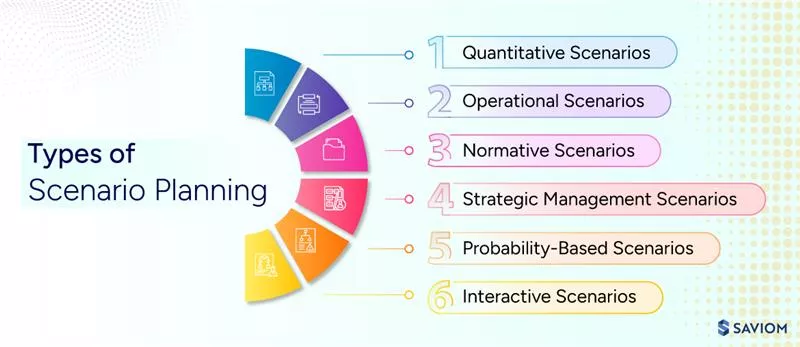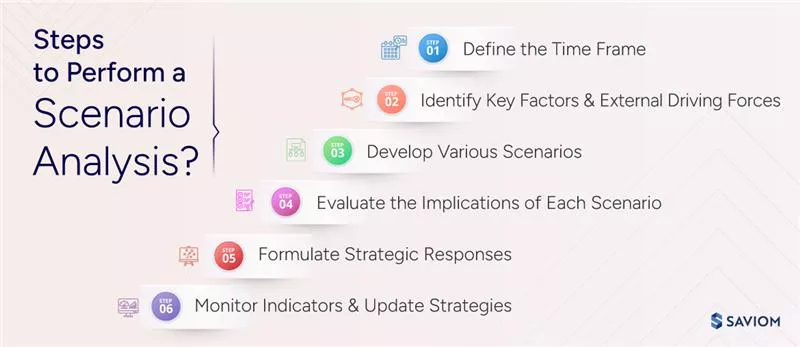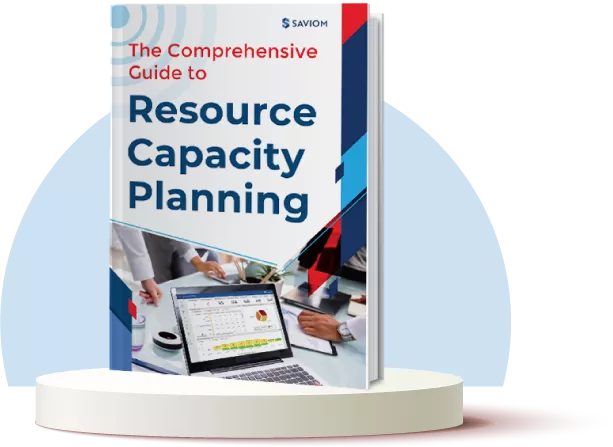Imagine you have a high-priority project in the opportunity pipeline. As you begin resource planning, you discover that a critical resource will be unavailable during the execution phase. Despite this setback, the project must still advance as planned. This is where scenario planning becomes essential!
It enables firms to model and simulate various scenarios in a sandbox environment and identify the most optimal resource plan within the existing constraints. This helps them overcome their unique business-specific challenges, streamline operations, improve profitability, and ensure long-term organizational sustainability.
In this blog, we will explore the nitty-gritty of scenario planning, including its definition, types, benefits, disadvantages, steps, and best practices.
Without further ado, let’s begin!
What is Scenario Planning?
Scenario planning, also called what-if analysis, is a strategic method that enables organizations to visualize and prepare for future possibilities. It involves factoring in key factors like changing client demands, resource shortages, budget constraints, etc., and developing multiple feasible scenarios to explore potential outcomes.
By using scenario planning, firms can assess the implications of a broad range of scenarios and identify the best one that will work for them. This informed decision helps them adapt strategies to address risks and opportunities and succeed in the face of uncertainties.
In the following section, we will understand various types of scenario planning.
6 Types of Scenario Planning
Each type of scenario planning is tailored to the respective strategic requirements and levels of variability. So, given below are a few types of scenario planning that firms can use –
Quantitative Scenarios
These data-driven approaches rely on numerical, historical, and statistical data to forecast potential business outcomes. Typically used by the financial department, this method helps them analyze and predict measurable variables such as revenue growth, cost fluctuations, and financial performance.
Operational Scenarios
Operational scenarios help businesses plan and prepare for the smooth functioning of day-to-day operations. By simulating scenarios for specific events like equipment failure, system outages, delivery delays, etc., operational scenarios enable firms to prepare for disruption and optimize workflows.
Read More: What is Operational Workforce Planning and How it Benefit the Organizations?
Normative Scenarios
This type of scenario planning is goal-oriented and helps businesses arrive at an ideal path to achieving their desired goals. Often executed by senior leadership or upper management, this method guides decision-making during instances like strategic visioning, sustainability planning, and policy development.
Strategic Management Scenarios
Typically, strategic management scenarios emphasize high-level planning by assessing possibilities that could impact the direction and growth of the company. Upper management uses these scenarios for long-term planning, which includes market expansion, brand positioning, and gaining a competitive edge.
Read More: What is Strategic Workforce Planning: Example, Benefits, and Best Practices
Probability-Based Scenarios
These scenario models involve estimating how probable each possible future outcome is based on past data, trends, and patterns. Typically performed by risk management or financial analysis teams, this approach factorizes risk and impact to prioritize scenarios that align with their strategic planning.
Interactive Scenarios
Unlike other types, interactive scenarios are dynamic and focus on the participation of internal and external stakeholders through collaboration. Generally used in fast-paced environments like crisis management, it incorporates real-time feedback and diverse perspectives to make ongoing adjustments to scenario models.
Read More: Who are Project Stakeholders? 7 Effective Ways to Manage Them

Having understood the types, let’s move on to the difference between scenario planning and forecasting.
Scenario Planning vs. Forecasting
Even though both scenario planning and forecasting are future-oriented and help firms beat uncertainties, they vary in their approach, purpose, and implementation. While scenario planning explores multiple possible futures, forecasting focuses on determining upcoming project requirements. It offers firms sufficient lead time to ensure the timely availability of the right resources at the right cost.
Given below is a detailed comparison of both –
| Traits | Scenario Planning | Forecasting |
|---|---|---|
| Objective | To explore multiple, feasible futures to guide decision-makers. | To foresee future trends or pipeline projects and determine upcoming requirements. |
| Focus | To devise proactive measures and contingency plans to reduce the repercussions of resource constraints on projects. | To estimate and plan future resource requirements for successful project completion. |
| Use of Data | Uses data by relying mostly on assumptions. | It relies mostly on historical data and patterns. |
| Time Horizon | Medium to long-term. | Adaptability & Flexibility |
| Adaptability & Flexibility | Highly flexible. | Limited flexibility. |
| Use Cases | High-level or strategic planning, project planning, etc. | Budgeting, inventory management, demand planning, etc. |
| Stakeholders | Active involvement of stakeholders to incorporate diverse perspectives and domain expertise. | Stakeholder involvement is minimal; subjective perspectives are excluded from the process. |
Read More: What is Resource Forecasting? A Guide for Project Managers
Given the difference, let us understand some advantages of scenario planning.
Benefits of Scenario Planning
While scenario planning helps businesses make informed decisions, it also offers other benefits. Let us look into some –
Ensures Effective Resource Planning
With the help of scenario planning, firms can simulate and compare different resource plans based on factors like resource unavailability, budget cuts, talent gaps, etc. This approach enables managers to identify the most realistic and cost-effective scenario that drives organizational efficiency.
Read More: What is Resource Planning, and Why is it Important in Project Management?
Helps in Proactive Risk Management
Scenario-based planning enables firms to model a range of possible risks, such as resource unavailability, schedule overruns, budget escalations, etc. Accordingly, firms can assess the impact of these vulnerabilities and develop risk mitigation plans to manage disruptions in advance.
Facilitates Informed Staffing Decisions
Managers can forecast staffing requirements by simulating various scenarios under conditions like resource shortages, skill gaps, attrition, underutilization, and more. This foresight enables them to make necessary staffing decisions such as training or upskilling, re-allocating resources, and planned hiring, to stay ahead of the curve.
Read More: What is Staff Deployment: Definition, Importance, and Key Strategies
Allows Proper Change Management
Scenario-based planning enables managers to model and simulate a range of transitional possibilities, such as implementing new software, organizational restructuring, process overhaul, shifting project priorities, etc. By analyzing how these changes could impact employees, managers can devise proper plans for change management to minimize resistance and maximize adaptability.
Provides Competitive Advantage
As per GoodFirms survey, “44% of organizations agreed that they perform scenario planning for competitive advantage.”
Scenario planning offers a strategic advantage by enabling businesses to anticipate possible market changes, technological shifts, economic transitions, or evolving customer behavior. This forward-thinking helps firms stay abreast of emerging opportunities, mitigate potential threats, if any, enhance agility, and maintain sustainable growth.
Read More: Using the Resource-based View Strategy for a Competitive Advantage
Having understood the benefits, let’s shift our focus to the disadvantages.
Disadvantages of Scenario Planning
Every advantage comes with its trade-offs, and the same applies to scenario planning. So, here are some disadvantages of scenario planning –
Demands Monetary and Time Investments
Scenario planning relies on input from stakeholders, cross-functional teams, expert consultants, etc., to develop a well-structured outcome through a rather long iterative analysis. This can be time-consuming and costly, especially for organizations working on limited budgets.
Requires Special Analysts & Expertise
The scenario planning process often demands subject matter experts (SMEs) or skilled analysts to gain a deeper insight into industry-specific trends, market risks, or financial planning. These experts may be scarce or busy, and their unavailability may lead to planning delays, or hiring them can incur additional costs.
Prone to Constant Changes
Another drawback of scenario-based planning is its susceptibility to change in the ever-evolving market landscape. They need regular revisions to incorporate the current realities, which might confuse the stakeholders. Ultimately, it can decline the relevancy of the scenario and negatively impact the efficiency of the planning process.
Risk of Bias & Inaccurate Assumptions
Lastly, scenario planning is completely based on assumptions and guesstimations of the individuals and data involved in the process. This can generate a risk of cognitive bias that can affect the data interpretation and framing of scenarios. Thus, due to their basis in subjective analysis, these scenarios and outcomes may be skewed and lack objectivity.
In the following section, we shall understand the steps to perform scenario analysis in firms.
How to Perform a Scenario Analysis?
By following the below steps, firms can perform top-notch scenario planning in their firm –
Define the Time Frame
The first step in scenario analysis is to establish a clear and relevant time period. This involves defining whether the scenario will focus on short-, medium-, or long-term future possibilities. Further, managers must also ensure that the selected time frame aligns with the overall planning horizon.
Identify Key Factors & External Driving Forces
Here, managers must identify and include internal and external influencing factors while performing scenario analysis. While internal factors include resource availability, utilization, resource shortages, etc., external drivers are market demand, economic shifts, and more.
Determine Critical Uncertainties
Managers must also identify and establish critical uncertainties that could negatively impact business outcomes and the growth trajectory. To do this, they can use a risk matrix to rank the uncertainties based on likelihood and impact; the higher the score, the greater the criticality. Generally, they must focus on two or three significant uncertainties to create effective scenarios.
Read More: What Are Resource Risks in Project Management & How to Mitigate Them?
Develop Various Scenarios
The fourth step is the implementation phase. Managers must create a graph plotting the two critical uncertainties in the X and Y axes. The other end of the respective axis will define the alternate extreme of the uncertainties. This creates four contrasting scenarios that range from the best and moderate to worst cases.
Evaluate the Implications of Each Scenario
Next, decision-makers must assess and evaluate the consequences of each scenario in terms of different variables such as resource requirements, financial planning, etc. This detailed examination helps understand future opportunities and risks well in advance.
Formulate Strategic Responses
Here, based on the information collected by evaluating each scenario, managers can develop suitable action plans, contingency solutions, and adaptive strategies. This helps firms respond effectively to future possibilities by facilitating proper planning, competent resource allocations, and optimizing workforce utilization.
Monitor Indicators & Update Strategies
The final step in this process is tracking indicators to understand how the scenario is evolving and updating strategies accordingly. This means managers must monitor every measurable indicator to identify shifts in internal and external factors and implement timely corrective actions to increase agility and responsiveness.

Now, let us understand the concept better with an example.
Scenario Planning Example
Suppose an IT firm is assessing the impact of emerging technologies on the services they provide. For this, they chose a medium-term time frame (5 years). After this, they identified emerging trends during this period, such as AI, cloud computing, quantum computing, etc., that were relevant during this selected time.
Next, they identify key factors like infrastructure, current talent pool, and financial ability as internal forces. Simultaneously, they determine demand for AI-driven tools, data privacy laws, and skill shortages as external factors. Based on these, the company determines two uncertainties –
- Cybersecurity regulations
- Cloud technology innovations
Both these factors influence the cost, feasibility, and trajectory of the project and pose an unclear future. The firm plots these uncertainties in an X and Y-axis graph and comes up with the following scenarios –
- Scenario 1: Rapid cloud technology innovation with strict cybersecurity regulations.
- Scenario 2: Rapid cloud technology innovation with relaxed cybersecurity regulations.
- Scenario 3: Slower cloud technology innovation with strict cybersecurity regulations.
- Scenario 4: Slower cloud technology innovation with relaxed cybersecurity regulations.
Now, the company has analyzed these scenarios and developed tailored strategies to meet these requirements effectively, which are as follows –
- For scenario 1, the firm can implement robust cloud technologies while appointing a dedicated compliance team for security.
- For scenario 2, the firm can simply roll out the technology for usage while giving minimal importance to compliance adherence.
- For scenario 3, the firm can emphasize security regulations and compliance policies while minimizing the investment in technology.
- For scenario 4, the firm can continue with the migration project while slowly adopting newer technologies and security regulations.
Once scenarios and strategies are in place, managers can monitor various indicators like market demand trends, internal performance metrics, regulatory changes, etc. This helps them identify the ideal scenario and revise the strategies to stay aligned with the latest requirements.
Read More: Top 15 Operational Metrics That a Business Should Monitor
The next section discusses a few best practices that could improve scenario planning in firms.
Scenario Planning Best Practices
While following the above steps could result in optimal scenario planning, it can be improved by incorporating these best practices. Let us understand them in detail –
Gather Relevant Data for Informed Decisions
Firms must meticulously collect accurate and relevant internal/external data to ensure trends, uncertainties, and assumptions are valid while creating scenarios. For example, by gathering historical data on a similar project, managers can evaluate project requirements to make informed resourcing decisions.
Assemble the Right Team & Seek Diverse Inputs
Scenario-based planning must not be a siloed activity; managers must ensure that they engage in cross-departmental collaboration when simulating any event or situation. This allows them to gather diverse perspectives, inputs, and actionable insights, which help avoid any knowledge gaps, ultimately creating a realistic scenario.
Identify Critical Triggers
Critical triggers are key events or signals, such as changing market demand regulatory shifts, geopolitical events, etc. Firms must establish clear guidelines to monitor these triggers in real time and respond swiftly with proactive strategies to avoid pitfalls and ensure seamless resource-centric workflows.
Ensure Practicality While Maintaining Flexibility
Managers must ensure the planned scenario is practical and aligns with the organization’s current capabilities. While practicality assures that strategies designed for each scenario are feasible and actionable, flexibility allows them to navigate sudden changes. Together, this improves responsiveness and resilience.
Utilize Scenario Planning Tools & Software
Lastly, firms can leverage scenario planning tools and software that help streamline data collection, simulate scenarios, and simplify the analysis process. It typically offers reports and dashboards that allow managers to simulate and compare various scenarios in real-time to select the most appropriate course of action.
Now, we shall see the importance of next-gen resource management software in scenario planning.
How Can a 5th Gen Resource Management Tool Enhance Scenario Planning?
SAVIOM’s robust resource management software offers a scenario modeling feature, called ‘What-if Scenario’ which allows users to model and simulate various outcomes in a sand box environment.
Here’s how managers can use it –
- After navigating to the ‘What-if Scenario’ functionality, the manager begins by creating a new ‘Title’ of the project on the ‘What-if Detail’ screen. They can also add desired ‘start’ and ‘end’ dates to the new project.

2. Next, from the ‘What-if Schedule chart’ tab, click ‘Select Project’ to add required projects for the scenario planning. This will populate the projects and respective resource allocations on the screen. By clicking on the drop-down against each project, managers can view the resources and their allocations.

3. Now, suppose a project must be completed within a specific budget. In that case, managers can use the ‘What-if Cost Report’ to view the cost rates of each resource assigned to selected projects, evaluate multiple resource combinations, and simulate different scenarios to choose the most cost-effective resource plan.

For instance, the manager decides to shift the allocation of Bennett Jackson to Week 18, April 2025 in the ‘What-if Schedule chart’ to check its impact on the cost report. At present, the original and updated forecast rate is shown as $1,980.

However, after moving the allocation, while the original rate remains the same, the updated forecast rate surges to $2,460 (highlighted in pink) indicating a budget overshoot. The manager identifies this scenario as not ideal and continues to adjust allocations of other resources to arrive at the most profitable outcome.

Read More: How Can You Make Data-Driven Decisions with Resource Management Software?
Conclusion
Scenario planning has emerged as a crucial strategic procedure that guides organizations in the face of uncertainties, risks, and opportunities. By visualizing various plausible scenarios, firms prepare themselves for a broad range of outcomes rather than relying on a single forecast. This empowers them to allocate resources efficiently, avoid costly disruptions, and beat market volatility effectively.
So, are you ready to future-proof your business using scenario planning?
The Glossary
Read More: Glossary of Resource Workforce Planning, Scheduling and Management










